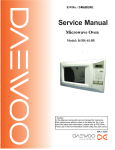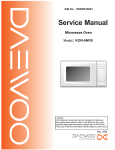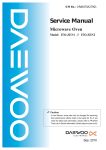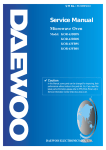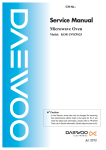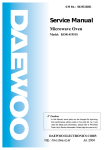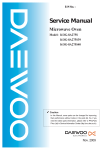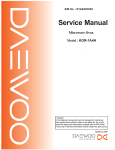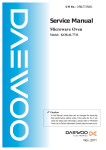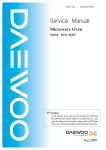Download Daewoo KOR-4A0B0W Service manual
Transcript
S/M No. : OR4A0B0W001
Service Manual
Microwave Oven
Model: KOR-4A0B0W
✔ Caution
: In this Manual, some parts can be changed for improving,
their performance without notice in the parts list. So, if you
need the latest parts information, please refer to PPL(Parts
Price List) in Service Information Center (http://svc.dwe.co.kr).
Jan. 2011
PRECAUTIONS TO BE OBSERVED BEFORE AND
DURING SERVICING TO AVOID POSSIBLE
EXPOSURE TO EXCESSIVE MICROWAVE ENERGY
(a) Do not operate or allow the oven to be operated with the door open.
(b) Make the following safety checks on all ovens to be serviced before activating the magnetron or other microwave source, and make repairs as necessary: (1) Interlock operation, (2) Proper door closing, (3) Seal and
sealing surfaces (arcing, wear, and other damage), (4) Damage to or loosening of hinges and latches, (5)
Evidence of dropping or abuse.
(c) Before turning on power to the microwave oven for any service test or inspection within the microwave generating compartments, check the magnetron, wave guide or transmission line, and cavity for proper alignment, integrity, and connections.
(d) Any defective or misadjusted components in the interlock, monitor, door seal, and microwave generation
and transmission systems shall be repaired, replaced, or adjusted by procedures described in this manual
before the oven is released to the owner.
(e) A microwave leakage check to verify compliance with the federal performance standard should be performed on each oven prior to release to the owner.
TABLE OF CONTENTS
PRECAUTIONS TO BE OBSERVED BEFORE AND DURING SERVICING TO AVOID POSSIBLE
EXPOSURE TO EXCESSIVE MICROWAVE ENERGY ......................................................................................................1
SAFETY AND PRECAUTIONS ...........................................................................................................................................2
1. FOR SAFE OPERATION ..................................................................................................................................2
2. FOR SAFE SERVICE PROCEDURES .............................................................................................................2
SPECIFICATIONS ...............................................................................................................................................................3
EXTERNAL VIEW................................................................................................................................................................4
1. OUTER DIMENSION.........................................................................................................................................4
2. FEATURES DIAGRAM......................................................................................................................................5
3. CONTROL PANEL ............................................................................................................................................6
INSTALLATION ...................................................................................................................................................................7
OPERATIONS AND FUNCTIONS.......................................................................................................................................8
DISASSEMBLY AND ASSEMBLY......................................................................................................................................9
INTERLOCK MECHANISM AND ADJUSTMENT.............................................................................................................16
TROUBLESHOOTING GUIDE ..........................................................................................................................................17
MEASUREMENT AND TEST ............................................................................................................................................21
1. MEASUREMENT OF THE MICROWAVE POWER OUTPUT ........................................................................21
2. MICROWAVE RADIATION TEST ...................................................................................................................22
3. COMPONENT TEST PROCEDURE ...............................................................................................................23
WIRING DIAGRAM............................................................................................................................................................24
PRINTED CIRCUIT BOARD..............................................................................................................................................25
1. CIRCUIT CHECK PROCEDURE ....................................................................................................................25
2. PCB CIRCUIT DIAGRAM................................................................................................................................28
3. P.C.B. LOCATION NO ....................................................................................................................................29
EXPLODED VIEW AND PARTS LIST...............................................................................................................................30
1. DOOR ASSEMBLY .........................................................................................................................................30
2. CONTROL PANEL ASSEMBLY......................................................................................................................30
3. GUIDE WIND ASSEMBLY ..............................................................................................................................30
4. TOTAL ASSEMBLY.........................................................................................................................................30
1
SAFETY AND PRECAUTIONS
CAUTION
This device is to be Serviced only by Properly Qualified Service Personel. Consult the Service Manual for Proper
Service Procedures to Assure Continued Safety Operation and for Precautions to be Taken to Avoid Possible
Exposure to Excessive Microwave Energy.
1. FOR SAFE OPERATION
Damage that allows the microwave energy (that cooks or heats the food) to escape will result in poor cooking and may
cause serious bodily injury to the operator.
IF ANY OF THE FOLLOWING CONDITIONS EXIST, OPERATOR MUST NOT USE THE APPLIANCE.
(Only a trained service personnel should make repairs.)
(1) A broken door hinge.
(2) A broken door viewing screen.
(3) A broken front panel, oven cavity.
(4) A loosened door lock.
(5) A broken door lock.
The door gasket plate and oven cavity surface should be kept clean.
No grease, soil or spatter should be allowed to build up on these surfaces or inside the oven.
DO NOT ATTEMPT TO OPERATE THIS APPLIANCE WITH THE DOOR OPEN.
The microwave oven has concealed switches to make sure the power is turned off when the door is opened.
Do not attempt to defeat them.
DO NOT ATTEMPT TO SERVICE THIS APPLIANCE UNTIL YOU HAVE READ THIS SERVICE MANUAL.
2. FOR SAFE SERVICE PROCEDURES
1. If the oven is operative prior to servicing, a microwave emission check should be performed prior to servicing the
oven.
2. If any certified oven unit is found to servicing, a microwave emission check should be performed prior to servicing the
oven.
(a) inform the manufacturer, importer or assembler,
(b) repair the unit at no cost to the owner,
(c) attempt to ascertain the cause of the excessive leakage,
(d) tell the owner of the unit not to use the unit until the oven has been brought into compliance.
3. If the oven operates with the door open, the service person should tell the user not to operate the oven and contact
the manufacturer and CDRH immediately.
CAUTION
MICROWAVE RADIATION
PERSONNEL SHOULD NOT BE EXPOSED TO THE MICROWAVE ENERGY WHICH MAY RADIATE FROM
THE MAGNETRON OR OTHER MICROWAVE GENERATING DEVICE IF IT IS IMPROPERLY USED OR
CONNECTED. ALL INPUT AND OUTPUT MICROWAVE CONNECTIONS. WAVEGUIDE FLANGES AND
PASKETS MUST BE SECURE. NEVER OPERATE THE DEVICE WITHOUT A MICROWAVE ENERGY
ABSORBING LOAD ATTACHED. NEVER LOOK INTO AN OPEN SAVEGUIDE OR ANTENNA WHILE THE
DEVICE IS ENERGIZED.
2
SPECIFICATIONS
POWER SUPPLY
MICROWAVE
230V AC, 50Hz SINGLE PHASE WITH GROUNDING
INPUT POWER
900 W
ENERGY OUTPUT
500 W
FREQUENCY
2,450MHz
OUTSIDE DIMENSIONS (W
CAVITY DIMENSIONS (W
H
H
D)
D)
424 x 223 x 317 mm
275 x 178 x 297 mm
CAVITY VOLUME
15 L
NET WEIGHT
APPROX. 9.0 Kg
TIMER
59 min. 90 sec.
POWER SELECTIONS
10 Levels
* Specifications are subject to change without notice.
3
EXTERNAL VIEW
1. OUTER DIMENSION
317
223
424
4
2. FEATURES DIAGRAM
1
2
3
w q
4
5
9
6
8
0
7
1 Door latch - When the door is closed, it will automatically shut off. If the door is opened while the
oven is operating, the magnetron will automatically
shut off.
7 Roller guide - This must always be used for cooking together with the glass cooking tray.
8 Glass cooking tray - Made of special heat resistant glass. The tray must always be in proper position before operating. Do not cook food directly on
the tray.
9 Viewing screen - Allows viewing of food.
The screen is designed so that light can pass
through, but not the microwave.
2 Door seal - The door seal surfaces prevent
microwaves escaping from the oven cavity.
3 Oven cavity
4 Control panel
0 Waveguide cover - Protects the microwave outlet
from splashes of cooking foods.
5 Door open button - To open the door push the
door open button.
q Safety interlock system
6 Coupler - This fits over the shaft in the center of
the oven cavity floor.
This is to remain in the oven for all cooking.
w Oven lamp - Automatically turns on during oven
operating.
5
3. CONTROL PANEL
1
2
4
3
6
5
7
8
9
1 DISPLAY - Cooking time, power level, indicators and the current time are displayed.
6 ONE TOUCH COOK - Used to cook or reheat
specific quantities of food.
2 AUTO COOK - Used to cook or reheat many of
favorite food.
7 TIME SET PAD - Used to set the cooking time
and the current time.
3 DEFROST - Used to defrost foods for time and
weight.
8 STOP/CLEAR - Used to stop the oven operation or to delete the cooking data.
4 POWER - Used to set power level.
9 START/+30 SEC - Used to start the oven and
also used to set a reheat time.
5 CLOCK - Used to set clock.
6
INSTALLATION
1. Steady, flat location
This microwave oven should be set on a steady, flat surface.
This microwave oven is designed for counter top use only.
2. Leave space behind and side
All air vents should be kept a clearance. If all vents are covered during operation, the oven may overheat and, eventually,
cause failure.
3. Away from radio, and TV sets
Poor television reception and radio interference may result if the oven is located close to a TV, radio, antenna, or feeder
and so on. Position the oven as far from them as possible.
4. Away from heating appliances and water taps
Keep the oven away from hot air, steam and splash when choosing a place to position it, or the insulation might be
adversely affected and breakdowns occur.
5. Power supply
• Check your local power source.
This microwave oven requires a current of approximately 4.5 amperes, 230 Volts, 50 Hz.
• Power supply cord is about 0.8 meters long.
• Used the voltage must be the same as specified on this oven. Using a higher voltage may result in a fire or other
accident causing oven damage. Using low voltage will cause slow cooking. We are not responsible for damage
resulting from use of this oven with a voltage of ampere fuse other than those specified.
• This appliance is supplied with cable of special type, which, if damaged, must be repaired with cable of same type.
Such a cable can be purchased from DAEWOO and must be installed by a qualified person.
6. Examine the oven after unpacking for any damage such as:
A misaligned door, broken door or a dent in cavity.
If any of the above are visible, DO NOT INSTALL, and notify dealer immediately.
7. Do not operate the oven if it is colder than room temperature
(This may occur during delivery in cold weather.) Allow the oven to become room temperature before operating.
EARTHING INSTRUCTIONS
This appliance must be earthed. In the event of an electrical short circuit, earthing reduces the risk of the electric shock
by providing an escape wire for the electric current. This appliance is equipped with a cord having a earthing plug. The
plug must be plugged into an outlet that is properly installed and earthed.
WARNING
Improper use of the earthing plug can result in a risk of electric shock. Consult a qualified electrician or service-man if
the earthing instructions are not completely understood, or if doubt exists as to whether the appliance is properly
earthed, and either : If it is necessary to use an extension cord, use only a 3-wire extension cord that has a 3-blade
earthing plug, and a 3-slot receptacle that will accept the plug on the appliance. The marked rating of the extension
cord should be equal to or greater than the electrical rating of the appliance, or DO NOT USE an extension cord.
7
OPERATIONS AND FUNCTIONS
11. Connect the mains lead to an electrical outlet.
12. After placing the food in a suitable container, open the oven door and put it on the glass tray. The glass tray must always
be in place during cooking.
13. Close the door securely.
14. The oven door can be opened at any time during operation by pushing the door open button on the control panel.
The oven will automatically shut off. To restart the oven, close the door and then touch the START pad.
15. Each time a pad is touched. a BEEP will sound to acknowledge the touch.
16. The oven automatically cooks on full power unless set to a lower power level.
17. The display will show “: 0” when the oven is plugged in.
18. Time clock returns to the present time when the cooking time ends.
19. When the STOP/CLEAR pad is touched during the oven operation, the oven stops cooking and all information retained.
To erase all information (except the present time), touch the STOP/CLEAR pad once more. If the oven door is opened
during the oven operation, all information is retained.
10. If the START pad is touched and the oven does not operate, check the area between the door and door is closed
securely. The oven will not start cooking under the door is completely closed or the program has been reset.
Make sure the oven is properly installed and plugged into the electrical.
Wattage output chart
The power level is set by touching the POWER pad. The chart shows the display, the power level and the percentage
of power.
Touch the POWER Pad
Power Level(Display)
Approximate Percentage of Power
Once
P-HI
100%
Twice
P-90
90%
3 times
P-80
80%
4 times
P-70
70%
5 times
P-60
60%
6 times
P-50
50%
7 times
P-40
40%
8 times
P-30
30%
9 times
P-20
20%
10 times
P-10
10%
11 times
P-00
00%
8
DISASSEMBLY AND ASSEMBLY
Cautions to be observed when troubleshooting.
Unlike many other appliances, the microwave oven is high-voltage, high-current equipment.
It is completely safe during normal operation.
However, carelessness in servicing the oven can result in an electric shock or possible danger from a short circuit.
You are asked to observe the following precautions carefully.
1. Always remove the power plug from the outlet before servicing.
2. Use an insulated screwdriver and ware rubber gloves when servicing the high voltage side.
3. Discharge the high voltage capacitor before touching any oven components or wiring.
(1) Check the grounding.
Do not operate on a two-wire extension cord.
The microwave oven is designed to be used while earthed.
It is imperative, therefore, to make sure it is earthed
properly before beginning repair work.
(2) Warning about the electric charge in the high voltage capacitor.
For about 30 seconds after the operation stopped and electric
charge remains in the high voltage capacitor.
When replacing or checking parts, short between oven chassis and
the negative high terminal of the high voltage capacitor by using a
properly insulated screwdriver to discharge.
4. When the fuse is blown out due to the operation of the monitor switch;
replace primary interlock switch, secondary interlock switch and interlock monitor switch.
5. After repair or replacement of parts, make sure that the screws are
properly tightened, and all electrical connections are tightened.
6. Do not operate without cabinet.
CAUTION : Service personnel should remove their watches whenever working close to or replacing the magnetron.
WARNING : When servicing the appliance, need a care of touching or replacing high potential parts because of
electrical shock or exposing microwave. These parts are as follows - HV Transformer, Magnetron,
HV Capacitor, HV Diode, HV fuse.
9
1. To remove cabinet
1) Remove four screws on cabinet back.
2) Pull the cabinet backward.
2. To remove door assembly
1) Remove two screws which secure the stopper hinge
top.
2) Remove the door assembly from top plate of cavity.
3) Reverse the above for reassembly.
NOTE : After replacing the door assembly, perform a check of correct alignment with the hinge and cavity front plate.
10
3. To remove door parts.
A06
A05
A04
A03
A02
A01
A07
A08
DOOR ASSEMBLY : 3511730500
REF No.
PART CODE
PART NAME
DESCRIPTION
A00
3511730500
DOOR AS
KOR-4A070S
A01
3511730510
DOOR PAINTING AS
KOR-4A070S
1
A02
3517011410
BARRIER-SCREEN *I
PE T0.1
1
A03
3513102200
HOOK
POM
1
A04
3515101300
SPRING HOOK
PW1
1
A05
3512211420
FRAME DOOR
HIPS SG-970 HG-1760H
1
A06
3517011400
BARRIER-SCREEN *O
TEMP GLASS T3.2
1
A07
3512303100
GASKET
PP
1
A08
3515205620
STOPPER HINGE *T AS
KOR-4A070S
1
1) Remove the gasket door from the door painting as.
2) Remove the barrier screen inner from the door painting as.
3) Remove the frame door from the door painting as.
4) Remove the stopper hinge top as from the door painting as.
5) Remove the spring hook and the hook from the door painting as.
6) Remove the barrier screen outer from the frame door.
7) Reverse the above steps for reassembly.
11
Q’TY
REMARK
4. Method to reduce the gap between the door seal and the oven front surface.
(1) To reduce gap located on part ‘A’
• Loosen two screws on the stopper hinge top, and then
push the door to contact the door seal to the oven front surface.
• Tighten two screws.
(2) To reduce gap located on part ‘B’
• Loosen two screws on the stopper hinge under, and then
push the door to contact the door seal to the oven front surface.
• Tighten two screws.
(3) To reduce gap located on part ‘C’
• Loosen the screw on the interlock switch assembly located
the top of the oven body.
• Draw the interlock switch assembly inward as possible to
engage with the hook on the door bottom.
• Tighten a screw.
(4) To reduce gap located on part ‘D’
• Loosen the screw on the interlock switch assembly located
the bottom of the oven body.
NOTE : A small gap may be acceptable if the microwave leakage does not exceed 4mW/cm2.
12
5. To remove control panel parts.
C/PANEL ASSEMBLY :
PKCPSWFLV0
REF No.
PART CODE
PART NAME
DESCRIPTION
Q’TY
B00
3516741380
CONTROL-PANEL AS
KOR-4A0B0W
B01
3516741360
CONTROL-PANEL
HIPS
1
B02
3516917810
BUTTON DOOR OPEN
HIPS SG-970 HG-1760H
1
B03
441G430171
SPRING BUTTON
SWP DIA. 0.7
1
B04
3518573800
SWITCH MEMBRANE
KOR-4A0B0W
1
B05
3513703810
LEVER DOOR OPEN
PP 5113MF6
1
B06
7122401211
SCREW TAPPING
T2S TRS 4*12 MFZN
3
B07
PKMPMSFLP0
PCB MAIN MANUAL AS
KOR-4A0B0W
1
REMARK
1) Remove the screw which secure the control panel sub as, push up two snap fits and draw forward the control panel
assembly.
2) Remove three screws which secure the PCB assembly to the control panel sub as.
3) Disconnect membrane tail from the connector of the PCB assembly.
4) Remove the PCB from the control panel sub as.
5) Remove the membrane, holder LED, lever door open, spring button and button door open from the control panel sub as.
6) Reverse the above steps for reassembly.
13
6. To remove guide wind parts.
GUIDE WIND ASSEMBLY :
3512530430
REF No.
PART CODE
PART NAME
DESCRIPTION
C00
3512530430
GUIDE WIND AS
KOR-4A070S
C01
3512530410
GUIDE WIND
PP
1
C02
3963513100
MOTOR SHADED POLE
230V 17W OEM-10DWC2-A07
1
C03
7121402511
SCREW TAPPING
T2S PAN 4X25 MFZN
2
C04
3511800300
FAN
PP+30%GLASS
1
C05
3518608300
NOISE-FILTER
DWLF-M12 B
1
1) Remove two screws for earthing and for fixing to rear-plate.
2) Remove the noise filter from the guide wind.
3) Pull the fan from the motor shaft.
4) Remove two screws which secure the motor shaded pole.
5) Remove the motor shaded pole.
6) Reverse the above steps for reassembly.
14
Q’TY
REMARK
7. To remove high voltage capacitor.
1) Remove the screw which secure the grounding ring
terminal of the H.V. diode and the capacitor holder.
2) Remove the H.V. diode from the capacitor holder.
3) Reverse the above steps for reassembly.
◆ High voltage circuit wiring
8. To remove magnetron.
1) Remove three screws which secure the magnetron.
2) Remove the magnetron.
3) Reverse the above steps for reassembly.
NOTE : Never install the magnetron without the metallic gasket plate which is packed with each magnetron to prevent microwave leakage. Whenever repair work is carried out on magnetron, check the microwave leakage.
It shall not exceed 4mW/cm2 for a fully assembled oven with door normally closed.
Metallic
gasket
plate
Wave guide Magnetron antenna
Magnetron
antenna
Cooling fin
Filament
terminal
<MAGNETRON>
Metallic gasket plate
15
9. To remove wind guide assembly.
1) Remove the screw for earthing.
2) Remove the noise filter from the wind guide.
3) Remove the screw which secure the wind guide assembly.
4) Draw forward the wind guide assembly.
5) Pull the fan from the motor shaft.
6) Remove two screws which secure the motor shaded pole.
7) Remove the motor shaded pole.
8) Reverse the above steps for reassembly.
10. To remove H.V.transformer.
1) Remove four screws holding the H.V.transformer.
2) Remove the H.V.transformer.
3) Reverse the above steps for reassembly.
16
INTERLOCK MECHANISM AND ADJUSTMENT
The door lock mechanism is a device which has been specially designed to completely eliminate microwave radiation when
the door is opened during operation, and thus to perfectly prevent the danger resulting from the leakage of microwave.
Primary
interlock switch
RD/GY
Hook
RD/RD
BK
Button
RD/WH
Monitor interlock switch
Lock lever
DOM switch
BL
BL
BK:BLACK
RD:RED
BL:BLUE
GY:GRAY
WH:WHITE
Mounting screw
(1) Primary interlock switch
When the door is closed, the hook locks the oven door. If the door is not closed properly, the oven will not operate.
When the door is closed, the hook pushes the button of the microswitch. Then the button of the primary interlock switch
bring it under ON condition.
(2) Secondary interlock switch and interlock monitor switch
When the door is closed, the hook pushes the lock lever downward. The lock lever presses the button of the interlock
monitor switch to bring it under NO condition and presses the button of the secondary interlock switch to bring it under
ON condition.
ADJUSTMENT :
Interlock monitor switch
When the door is closed, the interlock monitor switch should be "OFF" condition before other switches are "ON" condition.
When the door is opened, the interlock monitor switch should be "ON" condition after other switches are "OFF" condition.
(3) Adjustment steps
a) Loosen the mounting screw.
b) Adjust interlock switch assembly position.
Actuation distance of primary and secondary interlock switch shall be adjusted almost 0.7mm.
c) Make sure that lock lever moves smoothly after adjustment is completed.
d) Tighten completely a mounting screw.
NOTE :
Microwave emission test should be performed after adjusting interlock mechanism.
If the microwave emission exceed 4mW/cm2, readjust interlock mechanism.
17
TROUBLESHOOTING GUIDE
Following the procedure below to check if the oven is defective or not.
1. Check grounding before trouble checking.
2. Be careful of the high voltage circuit.
3. Discharge the high voltage capacitor.
4. When checking the continuity of the switches, fuse or high voltage transformer, disconnect one lead wire from these parts
and check continuity with the AC plug removed. To do otherwise may result in a false reading or damage to your meter.
NOTE : When electric parts are checked, be sure the power cord is not inserted the wall outlet.
Check wire harness, wiring and connected of the terminals and power cord before check the parts listed
below.
(TROUBLE 1) Oven does not operate at all ; any inputs can not be accepted.
CONDITION
CHECK
RESULT
Check continuity of interlock
monitor switch with door closed
Continuity
Fuse blows.
CAUSE
Malfunction of
interlock monitor switch
REMEDY
Replace
No Continuity
Check continuity of both primary
and secondary interlock switch
with door colosed
Check continuity of primary
inter-lock switch contact with
door partially open until interlock mon-itor switch contact
close (COM ↔ NO)
Check continuity of primary
winding of low voltage transformer
No Continuity
Malfunction of
interlock switch
Replace
Continuity
Continuity
Shorted contacts of primary
interlock switch.
Replace
No Continuity
0Ωor infinite
Approx.
310~420
(normal)
Fuse again
blows
Disconnect high voltage fuse
and operate the unit
18
Defective low
voltage transformer
Defective low
voltage trans-former
Replace
Replace
CONDITION
Outlet has
proper voltage Fuse
does not
blow.
CHECK
RESULT
CAUSE
REMEDY
No
Continuity
Defective magnetron
Replace
Check continuity of magnetron
Check continuity of
noise filter board
No
Continuity
Defective magnetron
Replace
Check continuity of
power supply cord
No
Continuity
Open power supply cord
Replace
Normal
Defective touch
control circuit
Replace
NOTE
All these switches must be replaced at the same time, please refer to “Interlock Mechanism And Adjustment”.
(TROUBLE 2) Display shows all figures selected, but oven does not start cooking, even though desired program and
time are set and START button is tapped.
CONDITION
CHECK
RESULT
CAUSE
REMEDY
Turn table
motor and
oven lamp
do not turn
on
Check continuity of primary interlock switch
No
Continuity
Malfunction of primary interlock
switch
Adjust or
replace
Check continuity of secondary
interlock switch
No
Continuity
Check D.C. voltage being supplied to RELAY (RY2) coil
0V
Defective touch
control circuit
Approx.
15 VDC
Faulty contacts of
RELAY (RY2) or
open relay coil
19
Malfunction of secondary interlock
switch
Adjust or
replace
Replace
Replace
(TROUBLE 3)
No microwave oscillation even though fan motor rotates.
CONDITION
CHECK
No
microwave
oscillation
Check continuity of high
voltage fuse
RESULT
CAUSE
REMEDY
Continuity
Replace high voltage fuse
Check continuity of high
voltage capacitor terminals
with wires removed
Continuity
Defective high
voltage transformer
Replace
Check continuity of high voltage
rectifier in forward and backward
direction with DC megger
Continuity in
backward
direction
Defective high
voltage rectifier
Replace
Connect megger leads to magnetron terminal and magnetron
body
Continuity
Defective magnetron
Replace
Check resistance of primary and
secondary coil of high voltage
transformer
0 Ωor ∞
Defective high
voltage transformer
Replace
No
Continuity
Defective magnetron
Replace
No
Continuity
Defective high
voltage transformer
Replace
Check continuity of magnetron
with wires removed
Check continuity of filament terminal of high voltage transformer
0V
Check D.C. voltage being supplied to RELAY (RY1) coil
Defective touch
control circuit
Approx
15 VDC
20
Faulty
contacts or
RELAY (RY1)
or open relay coil
Replace
Replace
(TROUBLE 4) The following visual conditions indicate a probable defective touch control circuit
1. Incomplete segments,
1) Segments missing.
2) Partical segments missing.
3) Digit flickering other than normal display slight flickering.
4) " :0" does not display when power is on.
2. A distinct change in the display are not on when they numbers is the
display.
3. One or more digits in the display are not on when they should be.
4. Display indicates a number different from one touched.
5. Specific numbers (for example 2 or 3) will not display when the panel is touched.
6. Display does not count down or up with time cooking or clock operation.
7. Oven is programmable and cooks normally but no display shows.
8. Display obviously jumps in time while counting down.
9. Display counts down noticeably too fast while cooking.
10. Display does not show the time of day when the STOP/CLEAR pad is touched. (in case of setting the present time)
11. Oven lamp and turntable motor do not stop although cooking is finished. Check if the RELAY 2 contacts close.
If they close, replace P.C.B assembly.
CONDITION
CHECK
Display does
not show
programming
at all, even if
keyboard is
touched.
Check each pad for
continuity of the membrane
keyboard for the following keyboard check procedure
RESULT
CAUSE
REMEDY
Normal
Malfunction
of the control circuit board
Replace the
control circuit
board
Abnormal
Malfunction
of the membrane
keyboard
Replace the
membrane
keyboard
NOTE
Before following the particular steps listed above in the troubleshooting guide for the failure of membrane keyboard, please check for the continuity of each wire-harness between the membrane keyboard and P.C.B.
assembly.
21
MEASUREMENT AND TEST
1. MEASUREMENT OF THE MICROWAVE POWER OUTPUT
Microwave output power can be checked by indirectly measuring the temperature rise of a certain amount of water
exposed to the microwave as directed below.
PROCEDURE
1. A cylindrical container of borosilicate glass is used for the test. It has a maximum thickness of 3mm, an external
diameter of approximately 190mm and a height of approximately 90mm.
The mass of the container is determined.
2. At the start of the test, the oven and the empty container are at ambient temperature. Water having an initial temperature of 10˚C ± 1˚C is used for the test. The water temperature is measured immediately before it is poured into
the container.
3. A quantity of 1000g ± 5g of water is added to the container and its actual mass obtained.
The container is then immediately placed in the centre of the oven shelf, which is in its lowest normal position.
The oven is operated and the time for the water temperature to attain 20˚C ± 2˚C is measured. The oven is
then switched off and the final water temperature is
measured within 60s.
NOTE 1 - The water stirred is before its temperature is
measured.
NOTE 2 - Stirring and measuring devices are to have a
low heat capacity.
4. The microwave power output is calculated from the formula
P = {4,187 • mw(T2-T1) + 0.55 • mc (T2-T0)}/t
where
P is the microwave power output, in watts ;
mw is the mass of the water, in grams ;
mc is the mass of the container, in grams ;
T0 is ambient temperature, in degrees Celsius ;
T1 is the initial temperature of the water, in degree Celsius ;
T2 is the final temperature of the water, in degrees Celsius ;
t
is the heating time, in seconds, excluding the magnetron filament heating-up time.
✻ The microwave power output is stated in watts, rounded off to the nearest 50W
CAUTION
1. Water load should be measured exactly to 1 liter.
2. Input power voltage should be exactly specified voltage (Refer to SPECIFICATIONS).
3. Ambient temperature should be 20 ± 2°C (68 ± 3.6°F)
✻ Heating time for power output: (T2 = T0)
A (second)
70
64
60
56
52
49
47
44
42
40
38
B (W)
600
650
700
750
800
850
900
950
1000
1050
1100
22
2. MICROWAVE RADIATION TEST
CAUTION :
1. Make sure to check the microwave leakage before and after repair of adjustment.
2. Always start measuring of an unknown field to assure safety for operating personnel from microwave energy.
3. Do not place your hands into any suspected microwave radiation field unless the safe density level is known.
4. Care should be taken not to place the eyes in direct line with the source of microwave energy.
5. Slowly approach the unit under test until the radiometer reads an appreciable microwave leakage from the unit
under the test.
PROCEDURES
1. Prepare Microwave Energy Survey Meter, 600cc glass beaker, and
glass thermometer 100˚C(212˚F).
2. Pour 275cc±15cc of tap water initially at 20±5˚C(68±9˚F) in the
600cc glass beaker with an inside diameter of approx. 95mm(3.5in.).
3. Place it at the center of the tray and set it in a cavity.
4. Close the door and operate the oven.
5. Measure the leakage by using Microwave Energy Survey Meter with
dual ranges, set to 2450MHz.
1) Measured radiation leakage must not exceed the value prescribed below. Leakage for a fully assembled oven with door normally closed must be less than 4mW/cm2.
2) When measuring the leakage, always use the 5cm(2in.) space
cone with probe. Hold the probe perpendicular to
the cabinet and door. Place the space cone of the probe on the
door, cabinet, door seem, door viewing screen, the exhaust air
vents and the suction air vents.
3) Measuring should be in a counter-clockwise direction at a rate of
1 in./sec. If the leakage of the cabinet door is
unknown, move
the probe more slowly.
4) When measuring near a corner of the door, keep the probe perpendicular to the areas making sure the probe end at the base of the cone does not get closer than 2 in. from any
metal. If it does not, erroneous reading may result.
23
3. COMPONENT TEST PROCEDURE
• High voltage is present at the high voltage terminal of the high voltage transformer during any cooking cycle.
• It is neither necessary nor advisable to attempt measurement of the high voltage.
• Before touching any oven components or wiring, always unplug the oven from its power source and discharge the
capacitor.
1. High voltage transformer
(1) Remove connections from the transformer terminals and check continuity.
(2) Normal readings should be as follows:
Secondary winding ...............Approx. 218.5 Ω±10%
Filament winding.....................................Approx. 0Ω
Primary winding ..............................Approx. 3.741 Ω
2. High voltage capacitor
(1) Check continuity of capacitor with meter on the highest OHM scale.
(2) A normal capacitor will show continuity for a short time, and then indicate 10MΩonce the capacitor is charged.
(3) A shorted capacitor will show continuous continuity.
(4) An open capacitor will show constant 10MΩ.
(5) Resistance between each terminal and chassis should be infinite.
3. High voltage diode
(1) Isolate the diode from the circuit by disconnecting the leads.
(2) With the ohmmeter set on the highest resistance scale measure the resistance across the diode terminals.
Reverse the meter leads and again observe the resistance reading.
Meter with 6V, 9V or higher voltage batteries should be used to check the front-back resistance of the diode, otherwise an infinite resistance may be read in both directions.
A normal diode’s resistance will be infinite in one direction and several hundred KΩin the other direction.
4. Magnetron
For complete magnetron diagnosis, refer to “Measurement of the Microwave Power Output”.
Continuity checks can only indicate and open filament or a shorted magnetron.
To diagnose for an open filament or a shorted magnetron.
(1) Isolate magnetron from the circuit by disconnecting the leads.
(2) A continuity check across magnetron filament terminals should indicate 0.1Ωor less.
(3) A continuity check between each filament terminal and magnetron case should read open.
5. Fuse
If the fuse in the primary and monitor switch circuit is blown when the door is opened, check the primary and monitor
switch before replacing the blown fuse.
In case the fuse is blown by an improper switch operation, replace the defective switch and fuse at the same time.
Replace just the fuse if the switches operate normally.
24
WIRING DIAGRAM
25
PRINTED CIRCUIT BOARD
1. CIRCUIT CHECK PROCEDURE
1. Low Voltage Transformer check
• The low voltage transformer is located on the P.C.B.
• Measuring condition: input voltage : 230V / Frequency : 50Hz
Terminal Voltage
LOAD
NO LOAD
(4,5)-6 or (7,8)-6
AC 14 V
AC 17 V
NOTE :
1. Refer to Circuit Diagram.
2. Secondary side voltage of the low voltage transformer changes in proportion to fluctuation of power source voltage.
3. The allowable tolerance of the secondary voltage is within ± 5% of nominal voltage.
2. Voltage check
• Key check point
NO
CHECK POINT
1
IC 1 PIN 5
2
IC 1 PIN 8
REMARK
5 VDC
5V
0V
3
T:20ms(50Hz)
T
IC 1 PIN 19 OR PIN 20
5V
T:250ns(4MHz)
0V
T
• Check method
NO
MEASURE POINT
1
MP1
2
MP2
WAVE FORM
REMEDY
REMARK
DC 5V ±0.25V
Replace Q8, R28, ZD3, C2, EC1
NO LOAD
DC 15V ±2.0V
Replace EC3, D11, D12, D13
NO LOAD
NOTE :
Each measure point must be measured with GND points.
26
MP1
MP2
GND
Measure Point
27
3. When there is no microwave oscillation
1) When touching START pad, oven lamp does not turn on.
Fan motor does not rotate, but cook indicator in display comes on.
- Check method
POINT
A
B
RELAY 2 ON
GND
5VDC
RELAY 2 OFF
15VDC
GND
STATE
2) When touching START pad, oven lamp turns on.
Fan motor and turntable rotate and cook indicator in display comes on.
- Check method
POINT
A
B
RELAY 1 ON
GND
5VDC
RELAY 1 OFF
15VDC
GND
STATE
4. When the door is opened during operation, the count down timer does not stop.
- Check method
POINT
A
B
1) DOOR OPEN
OPEN
5VDC
2) DOOR CLOSED
CLOSE
GND
STATE
CHECK NO
1
METHOD
REMEDY
Check the stage(ON, OFF) of the door open monitor
switch by resistance measurement.
Replace door open monitor switch.
5. When the digital clock does not operate properly.
→ refer to Circuit Diagram
POINT
WAVE FORM
5V
IC 1 PIN 8
0V
T
T:20ms(50Hz)
*If clock does not keep exact time, you must check resistor R12, R17, D8, C3 and zener diode ZD1.
28
2. PCB CIRCUIT DIAGRAM
29
3. PCB LOCATION NO.
NO
NAME
SYMBOL
SPECIFICATION
PART CODE
Q’TY
1
BUZZER
BZ1
BM-20K
3515600100
1
2
CAPACITOR CERAMIC
C1,2,3,8,9
50V 0.1UF Z AXIAL
CCZF1H104Z
5
3
CAPACITOR CERAMIC
C4,5,6,7
50V 1000PF Z AXIAL
CCZB1H102K
4
4
CAPACITOR ELECTRO
EC1
50V RS 10UF(5X11)
CEXE1H100A
1
5
CAPACITOR ELECTRO
EC2
50V RSS 220UF(10X16)
CEXF1H221V
1
6
CAPACITOR ELECTRO
EC3
25V RSS 1000UF(13X20)
CEXF1E102V
1
7
CONNECTOR WAFER
CN1
FCZ254-8
441M367130
1
8
CONNECTOR WAFER
CN2
YW396-725V
3519150550
1
9
DIODE SWITCHING
D1~10
1N4148
DZN4148---
10
10
DIODE RECTIFYING
D11~13
1N4004A AUTO 52MM
DZN4004A--
3
11
DIODE ZENER
ZD1
UZ -5.1BSB
DZUZ5R1BSB
1
12
DIODE ZENER
ZD2
UZ -3.3BSB
DZUZ3R3BSB
1
13
DIODE ZENER
ZD3
UZ -5.6BSB
DZUZ5R6BSB
1
14
FOAM
CR 8TX35X10
3517307000
1
15
LED DISPLAY
DP1
TOF-3491HG-B
DTOF3491HG
1
16
IC MICOM
IC1
HMS87C1408B
150LC1408B
1
17
PCB MAIN
M325
65X139
3514330740
1
18
RESISTOR
R13
1/6W 200 OHM 5%
RD-AZ201J-
1
19
RESISTOR
R1~6,8~10
1/6W 330 OHM 5%
RD-AZ331J-
9
20
RESISTOR
R15,27,28
1/6W 1K OHM 5%
RD-AZ102J-
3
21
RESISTOR
R21,26
1/6W 4.7K OHM 5%
RD-AZ472J-
2
22
RESISTOR
R12,17,19,23
1/6W 10K OHM 5%
RD-AZ103J-
4
23
RESISTOR
R24
1/6W 47K OHM 5%
RD-AZ473J-
1
24
RESISTOR
R11,16,20,22
1/6W 100K OHM 5%
RD-AZ104J-
4
25
RESISTOR
R7
1/6W 1M OHM 5%
RD-AZ105J-
1
26
RESISTOR
R25
1/4W 51 OHM 5%
RD-4Z510J-
1
27
RESISTOR
R31
1/4W 100 OHM 5%
RD-4Z101J-
1
28
RESISTOR
R29,30
1/2W 27 OHM 5%
RD-2Z270JS
2
29
RESONATOR CERAMIC
CR1
CRT-4.00MS
5P4R00MTS-
1
30
SW RELAY
RY1
G5G-1A-DT DC 12V
5SC0101123
1
31
SW RELAY
RY2
CS11-12SH
5SC0101128
1
32
TRANSISTOR
Q5,7
KTA1266Y AUTO
TZTA1266Y-
2
33
TRANSISTOR
Q6,8
KTC3198GR AUTO
TZTC3198GR
2
34
TRANSISTOR
Q1~4
KRA106M AUTO
TZRA106M--
4
35
TRANSISTOR
Q9,10
KRC106M AUTO
TZRC106M--
2
36
TRANS POWER
LVT1
DMR-63KFS
5EPV035306
1
37
WIRE COPPER 7.5MM
J1,2,4,5,7,8
1/0.52 TIN COATING
85801052GY
6
38
WIRE COPPER 10MM
J3,6,
1/0.52 TIN COATING
85801052GY
2
39
RESISTOR
R14 (RVCC)
1/6W 1K OHM 5%
RD-AZ102J-
1
30
EXPLODED VIEW AND PARTS LIST
1. DOOR ASSEMBLY
Refer to Disassembly and assembly.
2. CONTROL PANEL ASSEMBLY
Refer to Disassembly and assembly.
3. GUIDE WIND ASSEMBLY
Refer to Disassembly and assembly.
4. TOTAL ASSEMBLY
31
REF. NO
PART CODE
F01
F02
F03
F04
F05
F06
F07
F08
F09
F10
F11
F12
F13
F14
F15
F16
F17
F18
F19
F20
F21
F22
F23
F24
F25
F26
F27
F28
F29
F30
F31
F32
C00
F33
F34
F35
B00
F36
A00
F37
F38
F39
F40
F41
3516121600
3511415700
3517209710
7121400611
3517400620
3518907010
7121300611
3513601600
3512784570
3513822000
3513703800
4415A17352
4415A66600
3518571000
7122401211
3510319300
3512100900
3518301601
3513005800
3518400800
7S432X4081
3515205610
7S432X4081
3518704300
3517305800
7S312X40A1
3518125740
3516003700
3518003710
3516003700
3512527800
7S312X40A1
3512530430
7S312X40A1
35113AEQ0D
7S432X4081
3516741380
7122401211
3511730500
7S432X4081
3510811310
7112401011
3517203600
3512517500
PART NAME
CAVITY AS
COVER WAVE GUIDE
MOTOR SYNCRO
SCREW TAPPING
COUPLER
THERMOSTAT
SCREW TAPPING
LAMP
HARNESS MAIN
LOCK
LEVER LOCK
SW MICRO
SW MICRO
SWITCH PUSH
SCREW TAPPING
BASE
FOOT
CAPACITOR HV
HOLDER CAPACITOR
DIODE HV AS
SPECIAL SCREW
STOPPER HINGE *U
SPECIAL SCREW
FUSE HV
FOAM
SCREW SPECIAL
TRANS HV
SPECIAL SCREW
MAGNETRON
SPECIAL SCREW
GUIDE AIR
SCREW SPECIAL
GUIDE WIND AS
SCREW SPECIAL
CORD POWER AS
SPECIAL SCREW
CONTROL-PANEL AS
SCREW TAPPING
DOOR AS
SPECIAL SCREW
CABINET AS
SCREW TAPPING
TRAY
GUIDE ROLLER AS
DESCRIPTION
KOR-4A070S
PP 5113MF6
49TYD -5B
T2S PAN 4X6 MFZN
XAREC
OFF:120 ON:60 H #187
T2S PAN 3X6 MFZN
BL 240V 25W T25 C7A H187
KOR-4A0B0W
POM, BK
PP 5113MF6
VP-533A-OF SPNO #187 200G
VP-532A-OF SPNC #187 200G
V0303A2/MP101C
T2S TRS 4*12 MFZN
SBHG T0.5
PP DASF-130
2100VAC 0.79UF #187 65MM
SECC T0.4
ESJC13-12BX (CL01-12)
TT3 TRS 4X8 SE MFZN
SCP-1 T2.0
TT3 TRS 4X8 SE MFZN
5KV, 0.5A HV-41A50
CR 5TX10X155
T1 TRS 4X10 SE MFZN
S1S55A LA30
TT3 HEX 4X8 FLG MFZN
2M218HFL 6CF
TT3 HEX 4X8 FLG MFZN
SECC T0.5
T1 TRS 4X10 SE MFZN
KOR-4A070S
T1 TRS 4X10 SE MFZN
3X0.75 70X70 100-RTML
TT3 TRS 4X8 SE MFZN
KOR-4A0B0W
T2S TRS 4*12 MFZN
KOR-4A070S
TT3 TRS 4X8 SE MFZN
KOR-4A070S
T1 TRS 4*10 MFZN
GLASS
KOR-63150S
32
Q'TY
1
1
1
1
1
1
1
1
1
1
1
1
1
1
1
1
2
1
1
1
1
1
1
1
1
5
1
4
1
3
1
1
1
1
1
2
1
1
1
2
1
4
1
1
DAEWOO ELECTRONICS CORP.
1-2, Jeo-dong 1(il)-ga, Jung-gu, Seoul, Korea
C.P.O. BOX 8003 SEOUL, KOREA
TELEX: DWELEC K28177-8
CABLE: “DAEWOOELEC”
S/M NO. : OR4A0B0W001
PRINTED DATE: Jan. 2011
ABOUT THIS MANUAL
VISION CREATIVE, INC.
서울 종로구 통의동
6 번지 이룸빌딩 4 층
담
당
장형석 님
MODEL
KOR-4A0B0W (S/M)
접
2011.01.07
수
1차
2차
일
정
3차
4차
5차
제
판
규
격
인
한
쇄
MEMO 총 34p
11.01.07-전체신규 34p
11.01.10-17p, 25p 수정_ 신규 2p
11.01.13-28p 수정_ 신규 1p
연락처
VISION 담 당
방 문 수
TEL: 730-0660 FAX: 730-3788



































